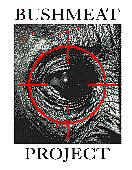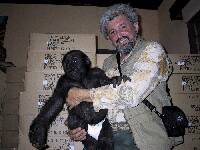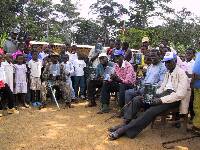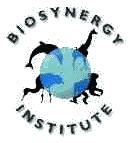 | contact: |
|
Dr. Anthony Rose, President of the Biosynergy Institute and Director of
Conservation for the Gorilla Foundation, has been in Cameroon since mid-November assessing two projects and supporting the production of a documentary film. We will bring you regular reports.
November 25th Report LETTER 2 FROM YAOUNDE, CAMEROON --
LETTER 2 FROM YAOUNDE, CAMEROON --Dr. Anthony Rose click any image for a larger view!! We have had an exciting start to our adventure. The Discovery channel cameras have captured some major events -- first for conservation in Cameroon. The educational programs involving Koko's Kitten took place here in Yaounde at the Zoo, and out in the forest in the village of Mettet, at the edge of Mefou National Park. Angelica Agwara performed her lessons on the Zoo lawn under a tall shade tree. She used the English version of Koko's Kitten, transmitting expertly the nuances of gorilla life in the forest and in captivity. In a very different setting - a mud walled schoolroom far from the city, another dedicated teacher taught the same lesson, in French. While over 350 students have had these lessons in Yaounde, this was the very first time village people had read from the new French version of the book. Without question, Koko et son Chaton was a tremendous success. The children reflected on what they had learned -- and faced the dilemma: are gorillas better off in the zoo, or in the wild? Dr. Kerry Bowman, Director of Research, helped the children examine this issue. The conclusion came with deep thought. Once a baby gorilla becomes an orphan of the bushmeat trade, it deserves the best of care and protection by people. But we must also protect them in their natural habitat. Ultimately that is their home. The concern for apes and other animals had become a given during the lessons. Reading about Koko and seeing her pictures has a remarkable effect. Not only the children, but the teachers, parents, the village chief and school administrators, are all amazed to learn that an animal they had considered savage had a gentle nature -- could communicate wants and feelings to people, and could care so much about others -- other gorillas, their human caretakers andfriends, even a small kitten. Kerry asked the question "will a hunter in the bush believe this story?" At first one young girl said "No, I think they will still want to hunt them." But a boy in the class said "if you read this book to them, they will see as we do that gorillas have feelings ... maybe they will also learn to care." "And how about your parents?" I asked. The conclusion was that they will change their minds when they learn what the children have learned. I told them I hoped they would make it so. Then I sat with the elders of the village, their chief, community leaders while they read about Koko et son chaton. "This is fantastic ... incredible ... we are so grateful to be taught this information and to learn that the gorilla can talk to people." Their reactions were as vibrant as those I had observed with other adults in years past. "I would like to tell Koko that we want also to be her friend. And we hope that our friendship with her, and with Dr. Penny, will last for a long long time," said the Chief. His fellow elders agreed.
Our commitment is redoubled. It will take years, support, involvement. But we are on the right track. Regards from Cameroon -- Tony Rose - 25 November 2000 The top photo (click for larger version) shows Tony Rose with orphan gorilla, Bobo, and 90 boxes of Koko et son Chaton at the CWAF storeroom. The above photo (click for larger) shows Village chief, elders, and school children and parents talking about their new copies of Koko et son Chaton, and discussing the needs of the people and of the animals in the forest. To discuss involvement now, email Kevin@koko.org (Kevin Connelly)
|
THE BIOSYNERGY INSTITUTE
P.O. Box 488
Hermosa Beach, California 90254
USAhttp://biosynergy.org/bushmeat/

 If you wish to support these vital new projects you are invited to make a
donation to the
If you wish to support these vital new projects you are invited to make a
donation to the 